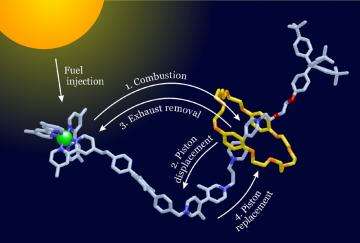Nano World: First solar-powered nano motor

An international team of scientists has created the first molecular motor powered solely by sunlight. By acting like pistons that move back and forth, these motors, which are only nanometers or billionths of meters across, could help read out data as ones and zeroes "for molecular photonics and electronics, two rapidly growing fields aimed at the construction of chemical computers," said researcher Vincenzo Balzani, a chemist at the University of Bologna, Italy.
Such motors could also operate nanovalves covering the surfaces of porous silica-based nanoparticles. Scientists could then use light to fill and empty the pores of these nanoparticles with molecules such as anti-cancer drugs. After doctors target cancers with these nanoparticles, "then light is used to trigger the release of the drug," said researcher J. Fraser Stoddart, a nanochemist at the University of California at Los Angeles.
The motor was designed and built over six years by researchers at the University of Bologna and UCLA. It essentially resembles a dumbbell roughly 6 nanometers long that threads a ring about 1.3 nanometers wide. The ring can move up and down the rod of the dumbbell but cannot go past the bulky stoppers at its ends.
There are two sites on the dumbbell's rod that the ring prefers to encircle. When one of the dumbbell's stoppers absorbs sunlight, it transfers an electron to one of these ports of call, driving the ring to then shuffle over to the other station. The ring returns to the old site after the electron transfers back to the stopper, allowing the cycle to begin all over again.
"The motions executed by the nanomotor are quite rapid. A full cycle is carried out in less than one-thousandth of a second," Stoddart said. That is roughly equivalent to "a car's engine running at 60,000 revolutions per minute," Balzani added.
"Noteworthy is the fact that this molecular motor does not require a chemical fuel to operate," said Devens Gust, a chemist at Arizona State University in Tempe who did not participate in this study. "Previous motors require fuel, including biological motors. The power for this system comes directly from light, with no need to move fuels around, consume them, and generate waste products. The analogy would be a solar-powered car vs. one fueled by a gasoline engine."
"This is an important step forward in the chemists' quest for molecular machines. I am impressed by the complexity of the synthesized structure," said Josef Michl, a chemist at the University of Colorado at Boulder who did not participate in this study.
At the moment, the nanomotors swim around fairly randomly in solution "and work independently and incoherently from one another, so that no work can actually be extracted from such a system," Balzani said. The researchers are now working to line these motors onto surfaces and into membranes so they can all work together "to obtain mechanical work on the macroscopic scale," Stoddart added. Their findings appeared online Jan. 23 in the Proceedings of the National Academy of Sciences.
Copyright 2006 by United Press International
















